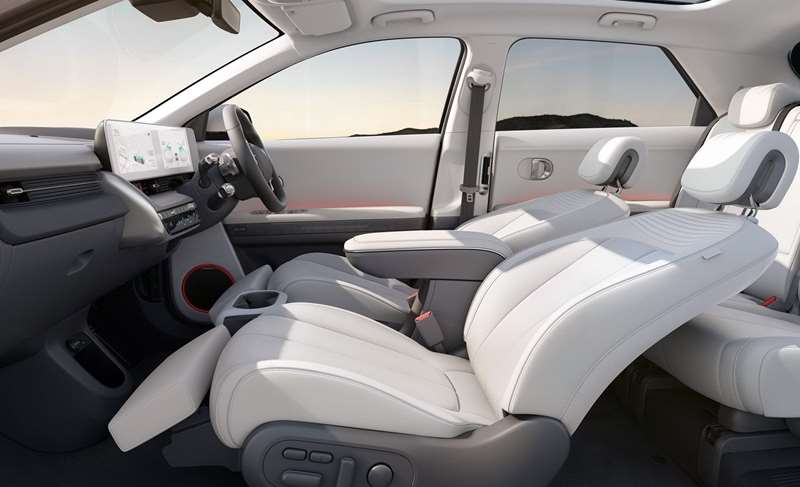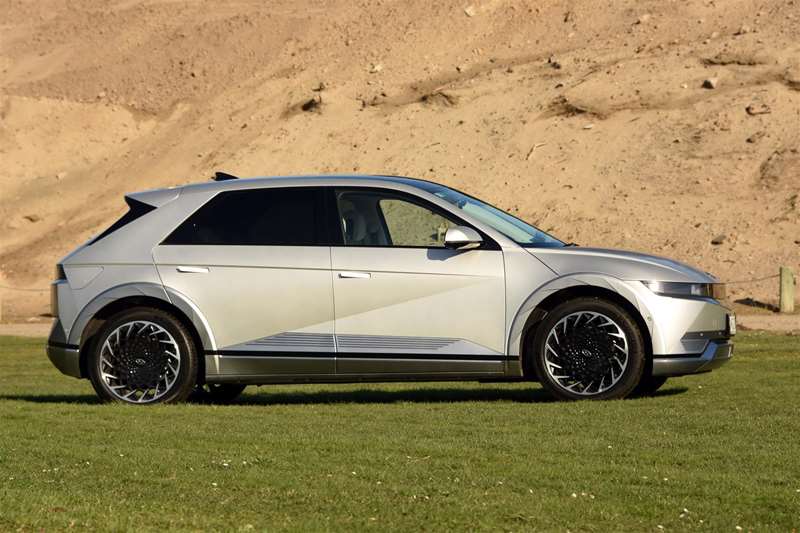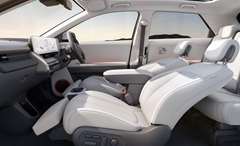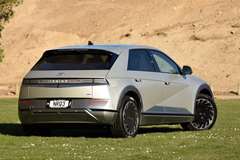The new Ioniq 5 represents a stepwise advance for Hyundai’s EV ambitions. David Thomson plugs into the electric vibe.
What’s new?
Hyundai introduced the world to its Ioniq sub-brand back in 2016, using the nameplate to launch a line-up of mid-sized hybrid and all-electric hatchbacks to start its move away from fossil fuel power.
Ditching the hybrid option in favour of a pure electric approach, and with its name now capitalised for extra effect, the latest Ioniq 5 is a massively more significant machine for a company that is increasingly well-established as a leader in affordable, contemporary EV design.
Most importantly, this latest arrival is the first of several vehicles coming from both Hyundai and its sister company Kia to use a new underlying platform designed solely for EVs. Called E-GMP (Electric-Global Modular Platform), this new chassis architecture is important because it is freed from the engineering and proportioning constraints that come from having to allow for an internal-combustion motor. This, in turn, allows for a far longer wheelbase relative to the vehicle’s overall length, bringing benefits for passenger space, and for the optimal positioning of the bulkiest component of an EV — its battery pack.
The Ioniq 5 points the way to a more sustainable motoring future in other ways too, most notably in the use of eco-friendly materials. These include bio-paints, the use of recycled plastics in the seat material, and by-products from sugar cane production for the roof headliner, carpet and seats.
Choices abound within the Ioniq 5 line-up, encompassing 58kWh and 72kWh battery systems, and a choice of single motor 125kW/350Nm or 160kW/ 350Nm front-drive vehicles, and a dual motor all-wheel-drive system with a combined 225kW/605Nm output.
Only the entry-level $79,990 two-wheel-drive sneaks in under the Government’s $80K EV rebate threshold. This variant takes the 58kWh battery pack and 125kW/350Nm motor. Next steps on the Ioniq 5 ladder are the 72kWh 160kW/ 350Nm two-wheel-drive for $89,990 and a more highly-specified version of the 72kWh 2WD — the Elite — with a $96,990 tag.
The all-wheel drives take a 72kWh battery in conjunction with two electric motors, comprising a primary 155kW/ 350Nm unit up front, and a secondary 70kW/255Nm motor at the rear. All-wheel drive is provided by having the front motor drive the front wheels, and the rear motor drive the back wheels.
Four-paw traction in the Ioniq 5 range opens at $94,990. Pricing for flagship the AWD Limited is $109,990 with a standard panorama sunroof, but there’s also the $3000 option — as fitted to the test car — of a solar panel roof that helps recharge the vehicle both on the move and parked.
What comes as standard?
The Ioniq 5’s standard active safety array sits under Hyundai’s SmartSense banner and includes adaptive cruise control with stop-go functionality, lane keeping and lane following assist, forward, blind-spot, and rear cross traffic collision-avoidance assist, driver attention alert, safe exit assist, and auto-dipping headlights. The flagship Limited also takes surround view and blind-spot monitors, remote smart parking, and parking collision-avoidance assist.
All variants feature full LED exterior lighting on the outside, with 19-inch alloys and 235/55 R19 tyres on all but the Elite and Limited, both of which ride on 20-inch wheels and 255/45 R20 rubber.
A dual widescreen display is standard fare, bringing together a centre-mounted 31cm infotainment centre screen and same-sized customisable digital instrument cluster. Other features across the range include keyless entry and push-button start, wireless phone charging, smart phone mirroring, satellite navigation, adjustable interior mood lighting, and paddle-shift controls for regenerative braking.
The Elite adds a centre LED garnish light up front, along with dual-projection LED headlights and rear privacy glass. This model also provides artificial leather trim, seat heaters for both the front and outboard rear occupants, heat pump air-conditioning, a heated steering wheel and premium Bose sound system. Along with its two roof options, the Limited adds a power-operated tailgate, front seat ventilation, power-operated rear seats, and special ‘‘relaxation’’ position for the front seat.
What does it look like?
Put simply, the Ioniq 5 has utterly stunning looks.
Hyundai claims its original 1970s Pony model as inspiration, and I can see some commonality in the use of strong, angular styling. But the classic design the Ioniq 5 echoes most strongly with its lines is Lancia’s Delta model of the 1980s, which was penned by the legendary Giorgetto Giugiaro’s Italdesign studio.
Despite retro inspiration, the overall look of the Ioniq 5 is determinedly futuristic. The crease-lines, with bold slash-lines across the doors, are crisp and assured, and the nose and associated clamshell bonnet are especially bold. The use of pixelated LED lights is most obvious during daylight hours at the rear. At night, the front of the car also lights up in a spectacular fashion.
The centres of the wheels echo the pixelated theme. Other elements of striking detailing include the rod-like door levers which pop out from their normal flush position when the car unlocks; they really are levers, not handles.
A less obvious piece of cleverness is the design disguises the fact that the Ioniq 5 is a big (and especially a wide) vehicle, with a precisely 3m wheelbase, and roughly 4.6m length and almost 1.9m width.
What’s it like inside?
Climb aboard the Ioniq 5 and you are likely to be struck by two things.
The first is that the sense of daring that marks the exterior look is equally apparent within the cabin. Having absorbed that welcome fact, an appreciation of the spacious nature of the vehicle will rapidly dawn.
The test car’s light interior trim certainly emphasised the airy feel, but the roominess is real, and due both to the Ioniq’s width, and the ability of the E-GMP platform to devote virtually all the space between the wheels to passenger accommodation.
Even the boot, which is quite shallow, has a reasonable 531-litre capacity, and there’s a small storage space under the bonnet too. Limousine-like legroom in the rear seats (power adjusting on the test car) is most impressive.
Head, leg and shoulder room is excellent upfront and the party piece is the special ‘‘relaxation’’ seating position, designed, apparently, so one can have a rest while the vehicle recharges. Both front seats recline to almost fully flat, with an extending leg rest to give a full first class experience.
The Ioniq 5 also boasts a wide array of in-cabin storage cubbies and compartments, such as a novel pedestal-style centre console that adjusts fore and aft, and a vast glovebox that pulls out like a drawer.
While the look of the dash and the double digital display screen are quite futuristic, conventional knobs are provided for the air-conditioning and to control sound system volume levels.
The quality of the cabin materials, fit and finish were first-rate on the test car. It will be interesting to see if the extensive use of recycled and other eco-friendly materials affects the durability of the interior.
What’s it like to drive?
A push on the start button brings the Ioniq 5 humming to life. Because the electric motors power the wheels directly, there’s no gearbox and consequently no gear lever. Instead, there’s a drive selector stalk nestled behind the steering wheel, with a knob that twists to engage drive and reverse or is pushed to select park mode.
A button on the other side of the stalk allows switching between economy, normal and sport modes. The urgency of the power delivery varies substantially depending on which mode is selected, though even in economy mode the test car was decently responsive.
The 225kW of power and 605Nm of torque provided represents truly substantial peak outputs and enables the dual-motor Ioniq to accelerate very rapidly indeed. A 0-100kmh sprint time of 5.2sec is claimed, and seems about right, but as ever with EVs it is the instant availability of peak power and torque and the smoothness of delivery that is most impressive.
Sport mode is overly aggressive for around-town work, but operating in either economy or normal modes, the test car wafted around Dunedin’s city streets effortlessly. Unsurprisingly, it’s very quiet in that environment too. Ride quality is reasonable, though the wide and relatively low-profile tyres thump a little when encountering major surface imperfections at city speeds.
One is aware of the Ioniq 5’s width in town, both on narrower lanes and when parking, but the surround and rear view camera system and parking sensors stop this factor from becoming too much of an issue.
Highway cruising is very relaxing, with decent ride quality and ample grunt for snappy overtaking and rapid progress up hills. The ability to alter the intensity of the regenerative braking via the steering wheel’s paddle-shift controls is handy, both for maximising energy recovery, and for maintaining optimum smoothness descending hills.
The tyres generate some rumble on coarse chip surfaces, but not enough to prevent normal toned conversation between front and back on an extended highway run, which demonstrates that the cabin is a pretty quiet place, even when travelling at 100kmh.
With the mass of its battery pack ideally located low down and between the wheels, the Ioniq 5 is well-balanced through the twists and turns. Its steering, while light, is accurate. For all that, the Ioniq 5 is by no means a sports car; it’s simply too big, too heavy and besides, has its suspension tuned with comfort rather than agility in mind.
Range and ease of EV motoring?
Having completed a Dunedin-Ranfurly-Dunedin run without pausing to recharge in the Hyundai Kona EV a few weeks prior, attempting to repeat that feat in the Ioniq 5 seemed obligatory.
This time around the trip — which is equal in length to a one-way run from Dunedin to Wanaka or Queenstown — was undertaken with four adults on board.
Travelling once again at typical open-road speeds, the trip worked out as planned, though with only a 30km range margin at the end of the 276km drive, rather than the 111km achieved in the Kona.
This was not unexpected, for while the Ioniq 5’s 72kWh battery is superior to that of the Kona’s 64kWh unit, the former is a larger and appreciably heavier machine, with wider tyres that will have more rolling resistance.
Energy consumption was 22.3kWh per 100km on the trip. This compared with a typical energy use of 20kWh/100km driving the Ioniq 5 in and around town, and an official combined cycle figure of 19kWh/100km. So, in terms of real-world range, it’s a 250km-300km machine on the open road and should manage well over 300km between recharging around town.
As an aside, the Ioniq 5 is rated to tow up to 1600kg.
Recharging at home is straightforward, but obviously a lot slower than using a 50kW commercial rapid charger.
Looking ahead, the battery charging system for all Ioniq 5 variants is compatible with the new-generation 800-volt 300kW ‘‘hyperchargers’’, the first of which has now been added to the existing ChargeNet national 50kW network in the upper North Island.
These new systems can add 100km of range with just five minutes of charging, and take an Ioniq 5 battery from 10% to 80% of charge in just 18 minutes.
Verdict
Stunningly styled, spacious, quick, and ready to take advantage of next generation re-charging technology, the Ioniq 5 is a hugely impressive new arrival on the burgeoning EV scene.
- Photos: David Thomson














